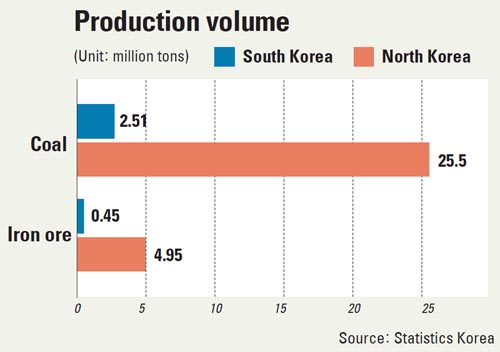South losing race for the North’s resources

China has already secured rights to natural resources such as iron ore and coal.
Most of China’s $750 million in imports from North Korea are natural resources.
“We have a deep interest in North Korea’s ample natural resources,” an official of China-based Shangdi Guanqun Investment Co., Ltd. told the JoongAng Ilbo in a previous interview.
“To facilitate the export of natural resources, we will invest $300 million first and construct a coal-fire power plant at the coal mine and build a railway, roads and harbors and piers [near it].”
It is clear that South Korea is losing the race for North Korea’s natural resources, observers said.
“There are growing concerns that North Korea could be selling the development rights of mineral resources to China at a very cheap price as the relationships between the two Koreas worsen and North Korea has no other market to turn to,” said Yoon Hong-gi, an official with Korea Resources Corp.
“We could be faced with a situation where we would have to repurchase those minerals at a higher value from China even when the relationship between the two Koreas improves.”

It wasn’t always that way.
During the Roh Moo-hyun administration, there were 10 people in the department. But after the entrance of the conservative Lee Myung-bak administration, relations between the North and South soured, squelching South Korean development projects north of the border.
According to Statistics Korea last month, the North Korean government indicated that the value of the minerals buried in its soil was roughly $6.1 trillion as of 2008.
This is 24 times more than the value of South Korea’s untapped natural resources.
South-North projects
After North Korea sank the South Korean vessel Cheonan last year, a joint project in Chongchon, Hwanghae came to a halt.
It had been the only mine jointly developed by the two Koreas.
A joint development pact was signed between the North and South during the Roh administration in 2003, and graphite started coming out of the mine in 2007.
A total of $6.65 million was spent on its development.
In return for the investment, South Korea was supposed to receive a steady supply of graphite for 15 years. But South Korea received graphite only twice - in 2007 and once more last January.
Wheels were in motion on another project in 2007 where South Korea would support North Korea’s textiles and chemical products industries, among others.
In return, the South was to receive natural resources.
In fact, South Korea subsidized North Korean projects to the tune of $80 million and actually received some zinc out of the deal.
The Koreas went further and started exploration of mineral resources in Dancheon, South Hamkyung, where it is suspected that large amounts of zinc and magnesite are buried.
However, as in the case of the Chongchon project, it was cancelled due to rising inter-Korean tension.
Meanwhile, the economic gap between North Korea and South Korea widened.
While the gross national income in South Korea as of 2009 was $837.2 billion, North Korea’s was at $22.4 billion.
By Suh Kyoung-ho [ebusiness@joongang.co.kr]










with the Korea JoongAng Daily
To write comments, please log in to one of the accounts.
Standards Board Policy (0/250자)